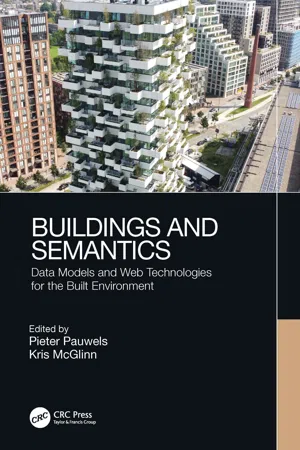
Buildings and Semantics
Data Models and Web Technologies for the Built Environment
Pieter Pauwels, Kris McGlinn, Pieter Pauwels, Kris McGlinn
- 300 pagine
- English
- ePUB (disponibile sull'app)
- Disponibile su iOS e Android
Buildings and Semantics
Data Models and Web Technologies for the Built Environment
Pieter Pauwels, Kris McGlinn, Pieter Pauwels, Kris McGlinn
Informazioni sul libro
The built environment has been digitizing rapidly and is now transforming into a physical world that is at all times supplemented by a fully web-supported and interconnected digital version, often referred to as Digital Twin. This book shows how diverse data models and web technologies can be created and used for the built environment. Key features of this book are its technical nature and technical detail. The first part of the book highlights a large diversity of IT techniques and their use in the AEC domain, from JSON to XML to EXPRESS to RDF/OWL, for modelling geometry, products, properties, sensor and energy data. The second part of the book focuses on diverse software solutions and approaches, including digital twins, federated data storage on the web, IoT, cloud computing, and smart cities. Key research and strategic development opportunities are comprehensively discussed for distributed web-based building data management, IoT integration and cloud computing. This book aims to serve as a guide and reference for experts and professionals in AEC computing and digital construction including Master's students, PhD researchers, and junior to senior IT-oriented AEC professionals.
Domande frequenti
Informazioni
Part I Semantics and data
Chapter 1 Building product models, terminologies, and object type libraries
CONTENTS
- 1.1 Introduction
- 1.1.1 A brief history of
CAD/ BIM - 1.1.2 Tackling
CAD/ BIM data exchange - 1.1.3 Seamless data exchange: the endemic problem
- 1.1.1 A brief history of
- 1.2 Concepts and definitions
- 1.2.1 Chapter definitions
- 1.3 Structured vocabularies
- 1.3.1 Structured vocabulary types
- 1.3.1.1 Classification systems
- 1.3.1.2 Taxonomy
- 1.3.1.3 Ontology
- 1.3.1.4 Data dictionary
- 1.3.1.5 Object-type library
- 1.3.2 Functionality and features
- 1.3.2.1 Object-oriented functionality
- 1.3.2.2 Semantics and logic
- 1.3.1 Structured vocabulary types
- 1.4 Digital building exchange formats and schemas
- 1.4.1 Semantic web and linked data
- 1.4.1.1 Resource description framework (
RDF) - 1.4.1.2 Web ontology language (
OWL) - 1.4.1.3 Simple knowledge organisation system (
SKOS)
- 1.4.1.1 Resource description framework (
- 1.4.2
ISOs for building classifications
- 1.4.1 Semantic web and linked data
- 1.5 Methods and techniques
- 1.5.1 Product and solid modelling techniques
- 1.5.2 Information collection mechanisms
- 1.5.3 Development and management
- 1.6 Practical examples in the
AECO industry - 1.6.1 Core vocabularies and linked datasets
- 1.6.2 Existing
AECO ontologies - 1.6.3 Existing
OTLs and data dictionaries
- 1.7 Open research challenges
- 1.7.1 System limitations
- 1.7.2 Open standard limitations
- 1.8 Conclusion
- Notes
1.1 Introduction
1.1.1 A brief history of CAD/BIM
A building can be conceived, though, as a collection of three-dimensional elements arranged in space... A detailed building representation might be provided by a computer, if it could s...